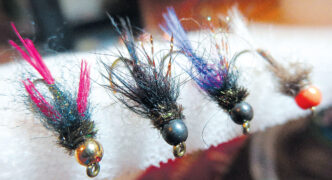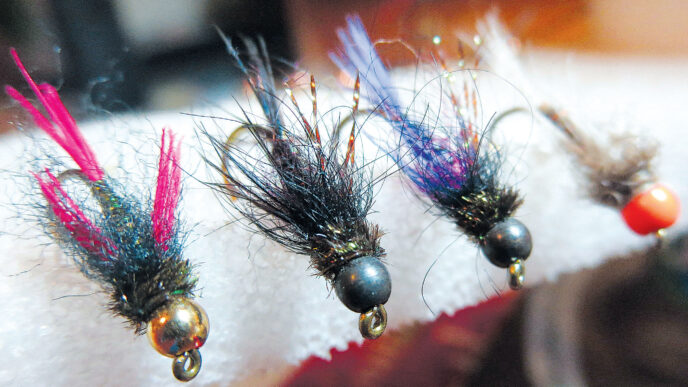The person who hooked me on collecting trout-fishing books was Angus Cameron, a legendary editor at Alfred A. Knopf and a keen angler himself. At the time I knew him, in the early 1970s, I worked for Knopf, too, in a capacity the Rolling Stones once described as an underassistant West Coast promotion man. My job was to arrange the Bay Area publicity for touring authors and to make sure they showed up for their interviews, not always as easy as it sounds, if a writer liked a cocktail or three with lunch. Often I had to throw my weight around to discourage further refills.
Twice a year, I flew to New York to visit the home office. That’s where I met Angus, who was then in his midsixties. I was only in my twenties, so I was impressed by his great age; in fact, he lived to be 93. Born in Indiana, he’d first taken to the outdoors on his paternal grandfather’s farm. He believed passionately in radical left-wing causes, and it had earlier cost him his job at Little Brown when some red baiters accused him of being a Commie sympathizer. Effectively blacklisted, he moved his family to the Adirondacks and then to Alaska, where they netted whitefish and sold them, with the help of a bush pilot, to the native people at 45 cents a pound.
Eventually the whitefish business lost its appeal, and Angus returned to Manhattan. No longer out of favor, he signed on at Knopf in 1959. In addition to books on fishing, hunting, and the outdoors, he included cooking among his interests. He edited Julia Child’s first book, Mastering the Art of French Cooking, and was the coauthor of The L.L. Bean Game and Fish Cookbook. In spite of his long career in publishing, he never felt entirely comfortable in the big city and once told me he survived by adhering to a single rule. He vowed never to run to catch a bus, a taxi, or a train. Maybe that accounted for his longevity. I’ve tried to follow the rule myself, albeit with less success.
I’d just begun to f ly f ish and still counted a 10-inch planter as a trophy when Angus gave me a new Knopf edition of Ray Bergman’s Trout, originally published in 1938. The unadorned title reflected Bergman’s homespun style, simple and direct. For some 25 years, he wrote countless articles and columns for Outdoor Life, even though he lacked a high-school education. His purpose, as he put it, was “to give the reader factual information gained and tested by my own practical experience, and to make it as interesting as my writing ability would allow.” He did that in spades. So influential was Trout that Bergman became known in the 1950s as the Dr. Spock of fly fishing.
I still recall the heft of that book, 451 pages long, and the color plates of flies, all painted by the wildlife artist Edgar Burke, a friend of Bergman’s — 440 wet flies alone and nearly as many dries. At home in California again, I pored over the text as if I faced a particularly challenging exam, which in a sense was true. I wanted to improve my skills and catch three-pound wild trout, not 10-inch planters anymore. The most important lesson Bergman conveyed to me was the virtue of patience. As I read along, I could see I’d been ruining my chances by getting carried away, too eager and excited to study a stream before I started casting.
I put that lesson to the test on the North Fork of the Yuba, a river that had skunked me once before. Instead of attacking it as usual, tossing out slashing casts like the whip work of Lash Larue, the old cowboy movie star, I exercised some self-control and simply observed for half an hour or so. In that brief time, the invisible became visible. I noticed little swirls where the trout were feeding subsurface and dainty, dimpled rises I’d missed in the past. The conditions called for nymphing, a technique Bergman introduced to American anglers in 1918. He imported his first nymphs from England, and they were very primitive, thick near the head, with only a few turns of hackle for the feelers.
So I tied on a Hares Ear and, to my utter surprise, soon landed a 14-inch rainbow, the largest trout I’d caught to date. That was gratifying, of course, but it also had a pernicious side effect. I’d always been an avid reader and decided that if I’d learned so much from Bergman, I ought to build the best library I could afford and thereby become a first-rate fly fisher as fast as possible, an idea at odds with the slow-moving, contemplative nature of the sport. I began haunting used bookstores such as Green Apple on San Francisco’s Clement Street, scouring the stacks for out-of-print gems, and splurged on new books, as well, acquiring Joe Brooks (who taught Bing Crosby, Ted Williams, and Jack Nicklaus to fly fish) and Len Wright, Roderick Haig-Brown, and Art Flick, Selective Trout and Trout Magic, among many other volumes.
Sadly, I fell victim to information overload. In a matter of months, I transformed the simple pleasure of angling into a supremely complicated enterprise. If I’d been heading for the lecture circuit, my treasure trove of lore and technical advice would’ve come in handy, but on a stream, it only confused me. Ernest Schwiebert’s Matching the Hatch was the book that finally did me in. It was an innovative, invaluable guide — no arguing with that — and I’m sure Schwiebert was an expert and a fine fellow, to boot, but his writing had a forceful, didactic tone that I felt compelled to follow even when my instincts dictated otherwise.
The low point of the Schwiebert era came on the Feather River near Chester, when I stumbled on a huge caddis hatch. The air was so thick with bugs I could almost reach out and grab a handful. Trout were actively feeding, too, but I forced myself to dip a net into the water and closely inspect what I’d found. Then it was time to match the hatch, or try to. I’d invested a small fortune in dries by then and sorted through them to determine the best pattern to use. A Tent Wing Caddis, or maybe a Parachute? Or the old reliable Elk Hair? But if so, what color? I had them in a rainbow variety. All this fussing ate up precious minutes and — you guessed it — the hatch ended before I wet a line.
As the old adage goes, many flies are tied to catch fly fishers, not fish, and I was the living proof. Never again would I repeat that mistake. The degree of scientific precision Schwiebert demanded just didn’t work for me. It was a question of temperament, really. Bergman’s voice was soothing, but Schwiebert’s sounded like a drill instructor’s to my ear. I cut way back on the number of flies in my box, and when it comes to caddis dries, I now rely on Elk Hairs in shades of olive, tan, brown, and black in sizes ranging from 12 to 18. Along with some Blue-Winged Olives, Adamses, terrestrials, and a few Stimulators in case of a stonefly hatch, they’re all I need or believe I need, which amounts to the same thing.
If Matching the Hatch curtailed my book-buying frenzy, it failed to kill it. But I became more selective, like the trout, and shied away from technical manuals. Instead, I read for pleasure and reaped plenty of it from McClane’s New Standard Fishing Encyclopedia, a volume as stout as my Oxford English Dictionary and well over a thousand pages long. In spite of its expensive price tag, the encyclopedia was a publishing phenomenon and sold almost a million copies worldwide. It was easy to understand why. The book’s subtitle said it all: International Angling Guide. McClane’s encouraged fantasies. Anglers devoured it in the same delirious way horny college boys used to devour Playboy.
True, the encyclopedia lived up to its name, packed with hard facts. You could bone up on the life cycle of steelhead or search out the best method for tying a Blood Knot, but I was much more intrigued by the travel aspect. (A. J. McClane had fished in 140 countries himself.) If you flipped through the pages, you could jump from the Irati River in Spain to the Firehole in Wyoming, each stream described in detail and often featuring a photo guaranteed to make your casting arm twitch. Salmon on the Fraser River in British Columbia, permit and bonefish in Belize, muskies in Minnesota, the list went on and on. It required only a cold beer and a little imagination to picture yourself fishing them all.
In reality, though, the most useful books I ever owned were the San Francisco Chronicle Tackle Box Guides, published back when the Chronicle was an actual newspaper. Jim Freeman, the author, was a superior outdoorsman, devoted to both hunting and fishing, and for 20 years, from 1970 to 1990, he contributed three columns a week to the paper, roving across Northern California in his trailer for eight months of the year, accompanied by his wife — it must’ve been a good marriage — and his two dogs.
Like Bergman, Jim Freeman was a no-nonsense type. He wouldn’t waste a word on a simile or a metaphor. He dealt in nuts and bolts. On my first trip to the Trinity River, I brought along his guide to the area, a slender volume that still managed to detail the stream, riffle by riffle and hole by hole. Freeman steered me toward the Stuart Fork in the Trinity Alps, and there, following his lead, I caught one trout after another. A quick check of Amazon tells me used copies are still available, and I may just order one for old time’s sake. Along with Trout, it speeded up my evolution from an inept novice to a moderately skillful fly fisher. I remain grateful for that. Such is the joy of collecting.
















